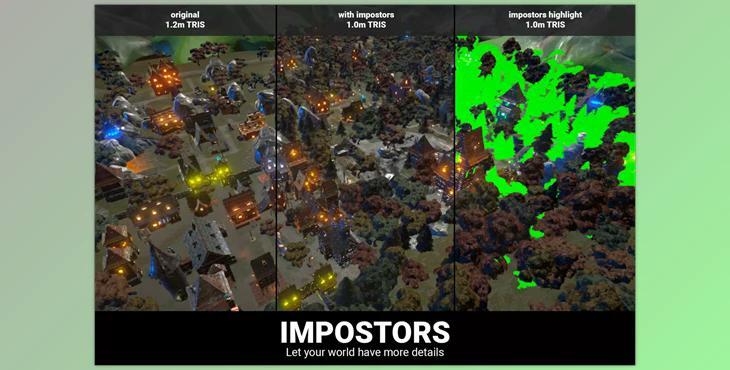Unity asset - Impostors – Runtime Optimization v2.0.1:
When striving to present expansive worlds with numerous objects, optimizing shaders, materials, and meshes becomes paramount. Enter Impostors – a solution to significantly streamline this process!
Impostors, essentially fake objects represented as quads, offer a visually convincing yet highly efficient means of rendering. Unlike traditional LODs (Level Of Detail), Impostors require no manual creation of additional assets or mesh adjustments, thus eliminating build size expansion. Moreover, Impostors seamlessly integrate with stylized custom shading, ensuring visual coherence across scenes.
The operational concept of Impostors is elegantly simple: a snapshot of the object from a specific angle is captured and displayed as a sprite, drastically reducing rendering overhead. As the camera moves, these snapshots are regenerated to maintain visual fidelity.
Determining when to employ Impostors depends on the nature of the project:
- Static Cameras: Ideal for scenarios where the camera rarely changes position, such as in VR experiences with teleportation mechanics or steady gameplay genres like visual novels and side-scrollers.
- First-Person Cameras: Perfectly suited for open-world FPS games, battle royales, and survival titles, offering seamless integration with Impostors.
- Flying or Top-Down Cameras: While feasible, continuous regeneration of impostor images may limit performance gains, as seen in flying or top-down games. However, with careful implementation, satisfactory results can still be achieved.
- Fast-Paced Camera Movement: Impostors may exhibit limitations in games with rapid camera movements, such as racing or flying simulators. However, effectiveness depends on specific project goals and requirements.
- Procedural Object Generation: In games featuring procedurally generated meshes without predefined LODs, Impostors excel by dynamically generating assets at runtime.
- Low-Poly Games: Impostors may be excessive for low-poly games, particularly on platforms with limited resources. Consideration should be given to target platform capabilities and scene complexity.
In conclusion, Impostors offers a versatile and efficient solution for optimizing runtime performance in Unity projects, particularly for large-scale environments with numerous objects. By leveraging Impostors intelligently, developers can achieve significant performance gains without compromising visual quality.
Limitations:
- Requires shaders that support forward rendering and RGBA ColorMask.
- Impostors' images need to be updated whenever lighting conditions change.
- At close distances, impostors may be distinguishable from the original object; they should be used at a maximum of 10% of the camera screen size.
- Limited to opaque and alpha-test/cutout shaders; does not support semi-transparent objects.
- Supports only one directional light plus ambient light.
- Offers a significant decrease in poly and draw call counts, enhancing performance.
- Compatible with stylized custom shading for artistic flexibility.
- No asset pre-processing or baking required, streamlining the workflow.
- Does not increase build size, ensuring efficiency.
- Generates impostors at runtime, eliminating the need for additional assets.
- Offers a fast setup process for convenience.
- Supports multiple cameras for versatile usage scenarios.
- Tested with VR platforms such as Oculus Quest for compatibility.
- Utilizes maximum performance using Jobs and Burst technologies.
- Supports moving objects for dynamic scenes and interactions.
